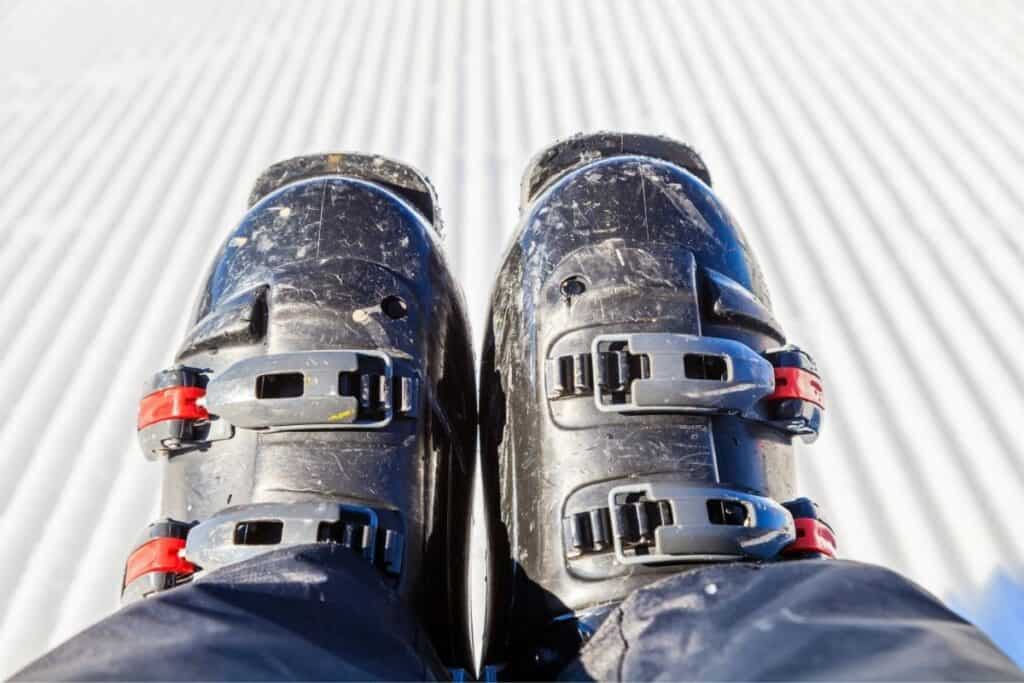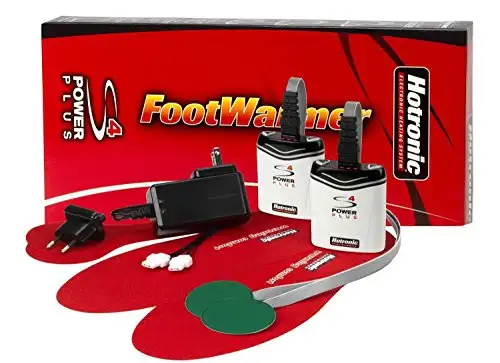
Any skier knows that nothing is worse than having cold or even wet feet when out on the slopes. Having cold toes is uncomfortable, affects your ability to ski smoothly, and makes it tough to nail parallel turns.
It has been proven that exposure of the extremities to cold can impair tactile sensitivity, occupational performance, muscle contractile, and more – all not good when skiing.
Make sure you don’t fall victim to this faux pas, and keep those tootsies warm while you ski!
Are Ski Boots Warm?
Ski boots are not warm on their own, but there are ways to keep your feet warm and dry during even the coldest conditions!
Some ways to avoid cold toes include thin ski socks, replacing boot liners, and adding boot warmers and heat reflectors.
Ski Boot Sizing
Having the correct size ski boot is another way to keep your feet warm and dry!
Skiers who rent their ski equipment may have a harder time with this as some rental boots may be almost double your shoe size, making them uncomfortable and not as safe. Before leaving the store, make sure that the boot fits you correctly.
Almost as important as the size is the fit of the boot itself. If your boots are not tight enough, they can lift during skiing.
Lifting the heels can decrease the amount of circulation, and poor circulation can ultimately cause cold feet. Keep in mind that if the size of the boot is too small, this can also reduce circulation.
Poor circulation can also result in frostbite if prolonged to temperatures of 28 degrees or less.
Lower Buckle Tightness
A common mistake is over-tightening the lower buckles on your ski boots. Most people feel the need to tighten their lower buckles for the top buckles to fit nicely.
However, you should do the opposite and loosen the bottom buckles. This helps reduce the amount of pressure from the lower part of your feet.
Wearing the right-sized boot will keep your heel locked into place without restricting blood flow.
Consider Boot Heaters
Boot heaters can be high maintenance but are effective in preventing cold toes.
Hotronic’s Foot Warmers easily install in all types of footwear and transfer simply from one pair to another. With its large oval shape, the heating element provides excellent coverage of the toes.
They work similarly to heating blankets as they have a cord running from the back (of the boot) and are attached to a rechargeable battery.
Replace Old Boot Liners
Boot liners eventually wear out and the liner is no longer able to keep moisture away. This is why it is important to update your liners frequently, especially if wearing well-used ski boots.
If you are a regular skier, you should replace your liner every year or two.
Boot liners that do not keep their shape will not hug the foot properly and will hold in cold air.
The best solution is to remove your old liners and replace them with foam-injecting liners to provide insulation for warmer feet.
Use Thermostat Heat Reflectors
Thermostats are a great option for skiers on a budget as they are heat reflectors placed inside the ski boots for warmth.
Instead of the warmth going from your feet to the ground, the heat goes from your feet into the boots, making your feet about 10-20 degrees warmer.
Let Your Feet Breathe!
Letting your feet breathe is important when it comes to circulation and is key to keeping them warm.
Unbuckle Your Boots
Every short break you get – lunch, bathroom, etc. unbuckle your boots to release any trapped air and allow warm air in. It exposes your feet to room temperature to switch the circulation up in your lower legs.
If you’re sitting inside a heated restaurant or lodge, you might want to remove your foot completely for a few minutes to warm up. Be careful when setting the foot down as you do not want to get it wet.
Ski Socks
Wearing thick ski socks does not always equal warmer feet since socks trap moisture, making your feet stay wet and cold instead of warm and dry.
A thinner ski sock should fit your foot correctly, allowing your feet to breathe.
Choose a pair that hits just above the calf to ensure the socks don’t slip while skiing. Avoid cotton socks as cotton traps moisture which will eventually cause your feet to get wet or cold.
Keep Dry
If your feet are wet, then it affects your whole body. Here are some key tips to help you stay dry.
Wear Dry Socks
As soon as you get back from skiing, make sure to take off your wet cold socks and replace them with ones that are warm and dry.
Some ski lodges might have a special boot dryer to dry your boots and liner. If not, turn your boots upside down over a heater or radiator.
Have several pairs of fresh socks on hand so that you have enough for each day after skiing.
If your socks do get damp, keep them inside at room temperature whenever possible. If you leave them outside, even if in the trunk of your car, the temperature of the boots, liners, and socks will lower.
Keep Your Core Temperature Up
Layer up with a base of thermals, a warm mid-layer, thick waterproof pants, and a ski jacket to keep your body and core temperature elevated.
Your core temperature can affect how fast your feet stay cool or warm. Be careful of over-layering since this can lower your temperature by trapping in moisture.
Boot Dryers
Not drying boots properly is one of the main reasons why people get cold feet. Make sure to remove the liners each day after skiing and place them near an indirect source of heat.
Boot warmers/dryers are heaters that plug into the wall and are put into the liners to evaporate trapped moisture.
Air-powered boot dryers circulate warm and dry air with a fan, like a hair dryer. This system pulls out moisture, making liners reusable.
Are Ski Boot Heaters Worth It?
A boot heater operates on batteries and sits in the interior of the shoe, adding extra heat to feet and toes. This makes sure that you ski comfortably, even in the coldest of temperatures.
Whether or not a ski boot heater is worth it depends on you. If you often ski in very cold climates or are prone to cold feet, a ski boot heat may be worth the investment.
Hotronic’s Foot Warmers easily install in all types of footwear and transfer simply from one pair to another. With its large oval shape, the heating element provides excellent coverage of the toes.
You will need to make a small cut underneath the liner to insert the wire.
Do’s and Don’ts of Cold Feet
Here are some simple ways to keep your feet warm.
Do:
- Wear dry socks
- Wear thin ski socks
- Replace old boot liners
- Install a ski boot heater
- Keep your core body temp warm
Don’t:
- Wear the wrong size boots
- Wear old or deformed boot liners
- Wear thick socks
- Wear wet socks
- Not wear enough clothing
The Final Say
Are ski boots warm? Alone, not necessarily.
However, tips such as wearing thin socks, wearing layers, and ski boot heaters will help keep your toes from getting cold and potentially ending your ski outing.
Whatever method or products you decide to purchase, make sure to apply common sense, such as not leaving your ski boots in the trunk overnight.
If you or someone in your family sweats a lot, consider purchasing a transportable ski boot dryer to keep their feet from trapping in the cold.
Related Articles
If you found this article helpful, then make sure to take a look at some of my other related articles linked below!

